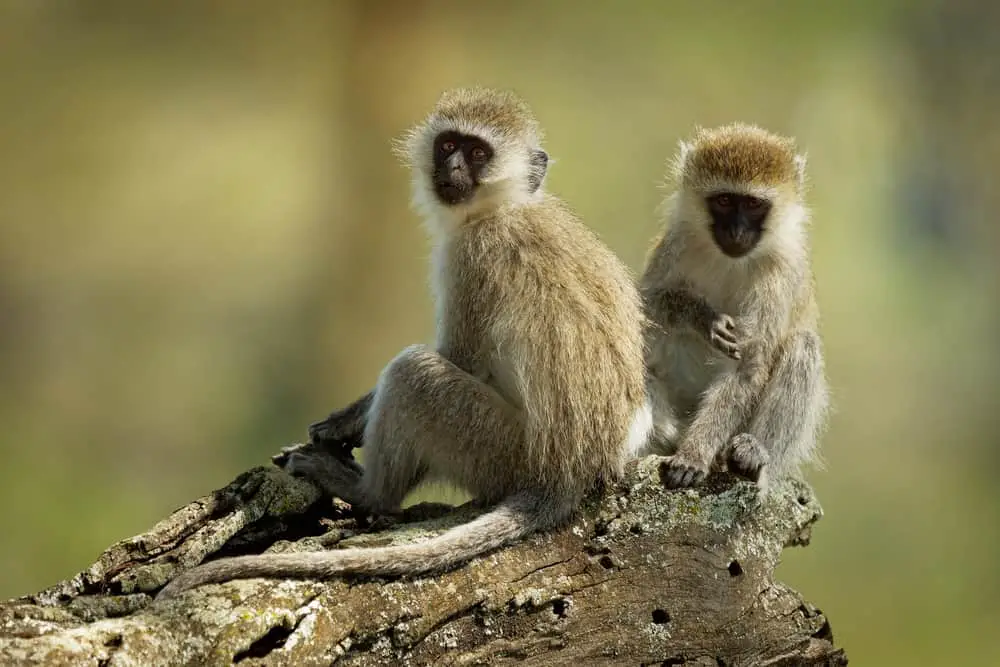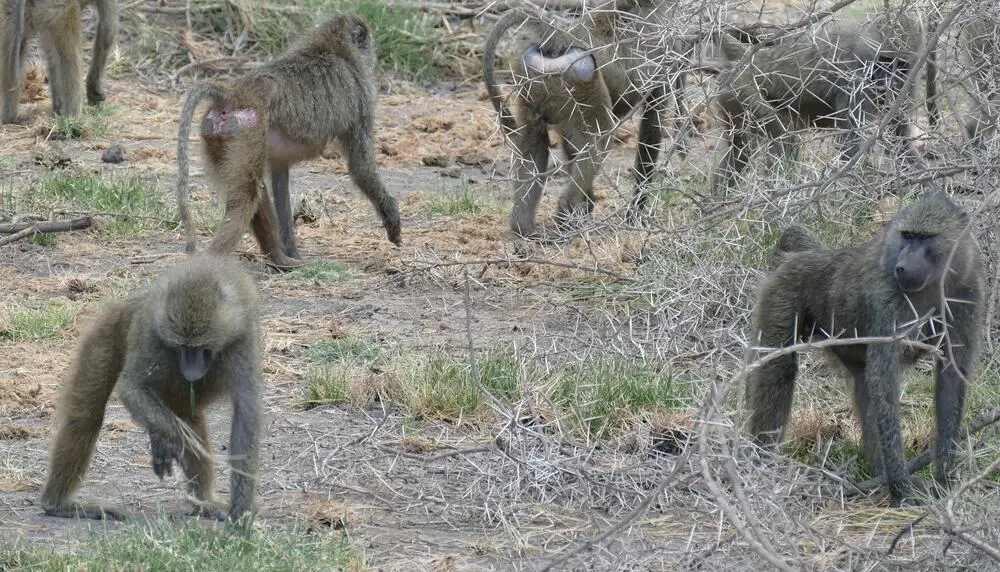Cercopithecidae is a family of Old World monkeys that includes over 140 species. These primates are found in Africa and Asia, and they have been the subject of extensive research due to their complex social behavior, cognitive abilities, and close genetic relationship to humans.
Cercopithecidae can be divided into two subfamilies: Cercopithecinae and Colobinae. The former contains most of the commonly known monkey species such as baboons, macaques, guenons, and vervet monkeys. The latter subfamily consists of leaf-eating colobus monkeys and langurs which are herbivores with specialized stomachs adapted for digesting leaves.
Despite this separation, both subfamilies share many common features such as distinctive facial expressions used for communication within groups, hierarchical societies where dominance often determines access to resources like food or mating partners, and complex vocalizations that vary by species but may include grunts, screams, barks or hoots.
Understanding cercopithecids’ biology has implications not only for our knowledge of primate evolution but also for conservation efforts aimed at protecting these threatened animals from habitat loss or hunting pressure.

Subfamilies, Tribes, and Genera
- Subfamily Cercopithecinae
- Tribe Cercopithecini
- Genus Allenopithecus – Allen’s swamp monkey
- Genus Allochrocebus
- Genus Cercopithecus
- Genus Chlorocebus
- Genus Erythrocebus
- Genus Miopithecus – talapoins
- Tribe Papionini
- Tribe Cercopithecini
- Subfamily Colobinae
- Genus Colobus – black-and-white colobuses
- Genus Piliocolobus – red colobuses
- Genus Presbytis – surilis
- Genus Nasalis – proboscis monkey
- Genus Procolobus – olive colobus
- Genus Pygathrix – doucs
- Genus Rhinopithecus – snub-nosed monkeys
- Genus Semnopithecus – gray langurs
- Genus Simias – pig-tailed langur
- Genus Trachypithecus – lutungs
Overview Of Cercopithecidae
Cercopithecidae is a family of Old World monkeys that includes over 140 species. These primates are found throughout Africa and Asia, inhabiting a wide range of habitats including forests, savannas, and mountains.
Cercopithecids are known for their complex social structures, intelligence, and adaptability.
The evolutionary history of cercopithecids dates back to the Oligocene epoch, around 30 million years ago. Over time, these primates diversified into different lineages such as colobines and papionins.
Humans have had interactions with cercopithecids dating back thousands of years through hunting for food and keeping them as pets or performing animals. Today, human-cercopithecine interactions continue in various forms such as habitat destruction due to urbanization and agriculture, primate tourism, and wildlife trade.
Understanding the natural history and behavior of cercopithecids can inform conservation efforts aimed at protecting these primates in the face of ongoing threats from humans.
Mandrills’ Predators Exposed: Unmasking the Threats
Taxonomy And Classification
Cercopithecidae is a family of old world monkeys that diverged from the new world monkeys about 40 million years ago. They are widely distributed across Africa and Asia, with over 140 recognized species.
The evolutionary history of cercopithecids has been shaped by various factors such as geographic isolation, climate change, and competition for resources. Over time, these primates have diversified into different genera and species based on their adaptations to differing environments.
Genetic diversity plays an essential role in the taxonomy and classification of Cercopithecidae. Studies show that there are significant genetic differences between closely related species within this primate family. This variation reflects both past events such as speciation and current processes like gene flow or adaptation to changing environmental conditions.
By analyzing specific sequences of DNA, researchers can identify distinct lineages and relationships among cercopithecids at different taxonomic levels. Such studies provide valuable insights into the evolutionary history of these primates while helping to refine our understanding of their systematics at finer scales.
Geographic Distribution And Habitat
Having discussed the taxonomy and classification of cercopithecidae, we can now turn to their geographic distribution and habitat.
Cercopithecidae are found in various regions across Africa and Asia, with some species also inhabiting forested areas in Europe. These primates occupy a wide range of ecological niches from tropical rainforests to semi-arid savannas, showcasing their remarkable adaptability.
However, like many other animal species around the world, cercopithecidae have been impacted by human activities such as deforestation, hunting, and climate change. Habitat loss due to human development has resulted in population declines for several species within this family.
In addition, increased contact between humans and cercopithecidae poses risks for disease transmission that can further threaten these animals’ survival. As we continue to study and monitor populations of cercopithecidae, it is important to consider how our actions impact these primates and take steps towards conservation efforts that preserve both them and their habitats.
Social Behavior And Communication
As we delve deeper into the world of cercopithecidae, one cannot ignore their fascinating social behavior and communication skills. These primates have developed a complex system to interact with each other, which involves both vocalizations and gestures. From loud calls to soft grunts, these monkeys use various sounds to convey different emotions like fear, anger or happiness.
Additionally, they also make facial expressions and body movements that are easily recognizable by others in their group. Moreover, cercopithecidae exhibit a strict dominance hierarchy within their groups where the more dominant individuals hold higher status than others. The hierarchy is maintained through aggressive displays such as baring of teeth, chest-beating or even physical fighting if necessary.
However, this does not mean that there is no harmony among them; on the contrary, social grooming plays an essential role in building strong bonds between members of the same group. This activity helps remove parasites from fur while providing opportunities for bonding and stress relief.
Cercopithecidae use various vocalizations (calls) to communicate.
They also show facial expressions and body movements.

Social grooming helps build strong bonds between members of the same group while removing parasites from fur.
In conclusion, it’s clear that social behavior and communication play a vital role in the lives of cercopithecidae. Their ability to use vocalizations and gestures effectively allows them to interact with each other seamlessly while maintaining a strict hierarchy within their groups. Furthermore, social grooming provides an opportunity for stress relief while promoting stronger bonds between members of the same group.
Diet And Digestive Adaptations
Diet and digestive adaptations are important aspects of cercopithecidae’s evolutionary history. The family has evolved to be highly adaptable in terms of food consumption, allowing them to thrive in a wide range of habitats. Some species have even developed specialized diets that enable them to exploit specific resources more efficiently.
Cercopithecids exhibit a variety of dental adaptations that reflect their dietary diversity. For example, colobus monkeys have reduced molar cusps and elongated incisors adapted for cutting leaves, while baboons and macaques have large molars with thick enamel ideal for grinding hard objects such as seeds and nuts. These adaptations play an essential role in the digestion process by breaking down tough plant fibers or hardened foods before they enter the stomach.
Furthermore, some cercopithecids possess sacculated stomachs where fermentation takes place, allowing them to extract additional nutrients from fibrous plant material consumed during feeding bouts. Overall, these dietary and anatomical adaptations illustrate how the cercopithecidae family has diversified over time to maximize their chances of survival through efficient utilization of available food sources.
Conservation Status And Threats
The diet and digestive adaptations of cercopithecidae are crucial in understanding their ecological significance. These primates have a diverse diet that includes fruits, leaves, seeds, insects, and small animals. Their digestive system has evolved to efficiently break down these foods by having a large stomach with multiple chambers allowing for fermentation and bacterial digestion. Additionally, they have elongated intestines that aid in the absorption of nutrients from fibrous plant material.
Despite their ecological importance, cercopithecidae face several threats that could lead to their extinction. Poaching for bushmeat is one of the primary causes of population decline among many species within this family. Cercopithecus mitis populations in East Africa have drastically declined due to poaching as well as habitat loss caused by deforestation for agricultural purposes.
However, conservation efforts such as poaching prevention measures and habitat restoration projects have shown promise in protecting endangered primate populations like those found within the cercopithecidae family.
Numeric List:
- Developing stricter laws against poaching
- Providing alternative sources of protein to local communities who rely on bushmeat hunting
- Creating protected areas where these primates can thrive without human interference
- Restoring degraded habitats through reforestation initiatives
- Implementing education and awareness programs to inform local communities about the importance of primate conservation and the negative impacts of hunting and habitat destruction.
Conclusion
Cercopithecidae, commonly known as Old World monkeys, are a diverse family of primates found throughout Africa and Asia. With over 140 species belonging to this family, they exhibit an array of physical characteristics, social behaviors, and ecological adaptations.
Taxonomically speaking, Cercopithecidae is divided into two subfamilies: the Colobinae (leaf-eating monkeys) and the Cercopithecinae (cheek-pouch monkeys). These subfamilies differ in their dental morphology, digestive physiology, and behavioral ecology. Moreover, within each subfamily there exist various genera that display unique evolutionary histories and morphological traits.
Geographically speaking, cercopithecids inhabit a wide range of habitats such as tropical rainforests, savannas, mountainsides, and even urban areas. Their ability to adapt to different environments has allowed them to thrive in both natural and human-modified landscapes. However, habitat loss due to deforestation and fragmentation poses a significant threat to many species within this family.
Socially speaking, most cercopithecids live in complex societies characterized by hierarchical structures and varied forms of communication. For instance, some species use vocalizations while others rely on visual displays or olfactory cues to communicate with conspecifics. Additionally, these animals often form strong bonds with members of their group through grooming rituals or play behavior.
In terms of diet and digestion, Cercopithecidae have evolved specialized teeth for processing tough plant material such as leaves or fruits. Furthermore, they possess enlarged cecums which serve as fermentation chambers where bacteria break down cellulose into digestible compounds.
Conservation-wise speaking, many cercopithecid species are threatened by hunting for bushmeat or pet trade as well as habitat degradation caused by climate change or human activities. Therefore conservation efforts must be directed towards protecting their remaining populations while also promoting sustainable development practices.
Overall, the study of Cercopithecidae offers a fascinating glimpse into the diversity and complexity of primate evolution. From their physical adaptations to their social dynamics, these animals have much to teach us about our own place in the natural world.
By conserving them we not only ensure their survival but also enrich our understanding of biodiversity and ecological interconnections.

